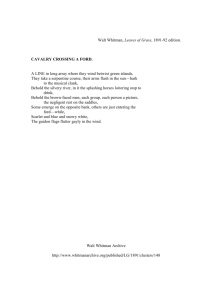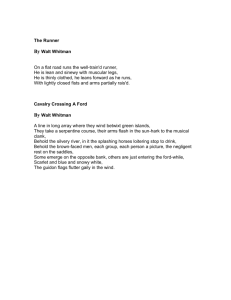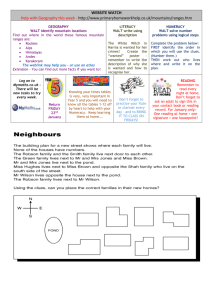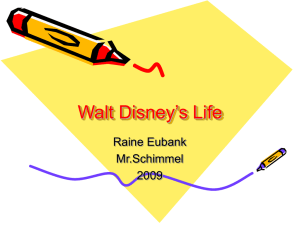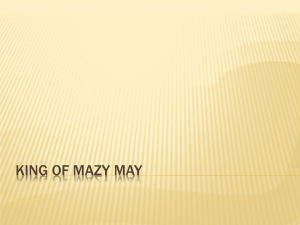Sample.student.paper.comments
advertisement
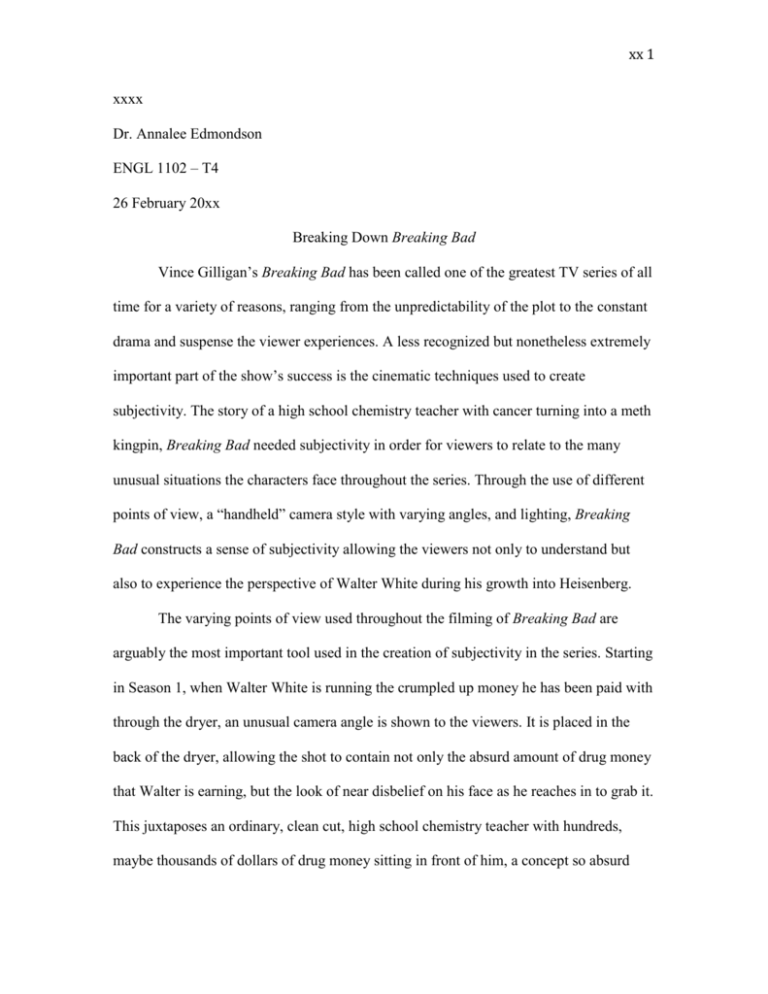
xx 1 xxxx Dr. Annalee Edmondson ENGL 1102 – T4 26 February 20xx Breaking Down Breaking Bad Vince Gilligan’s Breaking Bad has been called one of the greatest TV series of all time for a variety of reasons, ranging from the unpredictability of the plot to the constant drama and suspense the viewer experiences. A less recognized but nonetheless extremely important part of the show’s success is the cinematic techniques used to create subjectivity. The story of a high school chemistry teacher with cancer turning into a meth kingpin, Breaking Bad needed subjectivity in order for viewers to relate to the many unusual situations the characters face throughout the series. Through the use of different points of view, a “handheld” camera style with varying angles, and lighting, Breaking Bad constructs a sense of subjectivity allowing the viewers not only to understand but also to experience the perspective of Walter White during his growth into Heisenberg. The varying points of view used throughout the filming of Breaking Bad are arguably the most important tool used in the creation of subjectivity in the series. Starting in Season 1, when Walter White is running the crumpled up money he has been paid with through the dryer, an unusual camera angle is shown to the viewers. It is placed in the back of the dryer, allowing the shot to contain not only the absurd amount of drug money that Walter is earning, but the look of near disbelief on his face as he reaches in to grab it. This juxtaposes an ordinary, clean cut, high school chemistry teacher with hundreds, maybe thousands of dollars of drug money sitting in front of him, a concept so absurd xx 2 that it makes the scene comical. This establishes an important baseline for Walter as a character that will give him room to grow into a hardened criminal throughout the series. At this point Walt doesn’t belong in the drug trade, and techniques like this highlight his inexperience and softness until his dark alter ego Heisenberg is born. Another example of camera point of view occurs almost every time that meth is cooked in the RV; the actual cooking process is seen mostly through Walt’s eyes. This first person point of view shows how much care Walt has for his craft. The viewer can almost feel the precision of his measurements and the skill in his cooking, which would be much harder to experience if the camera were just shooting the cook from a distance. Another technique used in Breaking Bad is the handheld style of cinematography utilized at times to show characters’ emotions. As Nick Schager points out in his essay “Stylized Realism: The Cinematography of Breaking Bad,” “greater visual shakiness emerges whenever a character is wracked by stress, fear, or some sudden shock to their system” (Schager). This is evident when Tuco snorts Walt’s ultra pure meth and the camera begins to lose stability. Conversely, when Walt’s confidence is blossoming as a result of getting away with murder, an abnormal sense of stability is present in the shots, known in the film industry as Steadicam (Bunting). This shows Walt’s newfound confidence in his role as a drug dealer, and this stability will often be present as he grows into his Heisenberg persona. The stability or jitteriness of the camera is often accompanied by camera angles meant to amplify the emotions being portrayed. Confidence and stability are often accompanied by angles looking up at Walt, while shock and discomfort is generally portrayed from Walt’s point of view or one that is looking down on him. One of the most iconic scenes in the show occurs when Walt is xx 3 having an argument with Skylar, his wife, who is worried that his business is putting him and the family in danger. During the argument, the camera is at eye level with them both on the bed, shaking fairly noticeably, until Walt takes control of the situation. He stands up, and with the camera pointing up at him it suddenly goes still. Instead of fearing the danger of men knocking on his door, waiting to kill him, he confidently asserts, “I am the one who knocks!” The steadiness of the camera in this scene magnifies the mood already being displayed through Walt’s actions, and turns a simple phrase into a bone-chilling assertion of dominance. The lighting used to create subjectivity in Breaking Bad is almost iconic, given that a simple all-black silhouette of a man in a pork-pie hat is enough for anyone who has seen the show to associate with Heisenberg. Walt’s alter ego is almost always shrouded in shadow, from his cook sessions in the underground superlab to most encounters he has distributing his product. By the final season, entire episodes go without shots of Walter in full light, showing that he has transformed almost entirely into the dark, ruthless Heisenberg. Some of the only times Walt is shown in full light are when he is holding his infant daughter, and even then there is often shadow on one side of his face. This twofaced effect emphasizes Walt’s double life, showing he is a loving father as well as a murdering criminal. Breaking Bad cinematographer Michael Slovis mentions the focus that was placed on lighting in an interview with Dave Bunting in August 2013. Slovis recalls that during the construction of the set for the superlab, such emphasis was placed on lighting that three different systems, “I would have a lighting scheme for cooking, a scheme for maintenance, a scheme for post-cooking…” (Bunting) Each different lighting xx 4 setup produced different effects regarding the mood of the scene and of Walt himself, contributing to the ability of the viewer to feel what he felt. The techniques employed by Vince Gilligan in order to subjectify Walter White’s transformation into a crystal methamphetamine kingpin are basic cinematic effects, however his combined use of them magnifies the effect each has on the viewers. Gilligan was successful in his efforts to create subjectivity in Breaking Bad, and his use of point of view, camera stability and angles, and lighting allow viewers to fully experience Walt’s growth. xx 5 Works Cited Bunting, Dave. "Gliding Over All: An Interview with "Breaking Bad" Cinematographer Michael Slovis." RogerEbert.com. N.p., 7 Aug. 2013. Web. 26 Feb. 2014. <http://www.rogerebert.com/balder-and-dash/gliding-overall-the-cinematography-of-breaking-bad-season-2>. Gilligan, Vince, prod. "Breaking Bad." Breaking Bad. AMC. 2008. Television. Schager, Nick. "Stylized Realism: The Cinematography of Breaking Bad, Season 1." RogerEbert.com. N.p., 14 Aug. 2013. Web. 26 Feb. 2014. <http://www.rogerebert.com/balder-and-dash/cinematography-ofbreaking-bad-season-1>.
